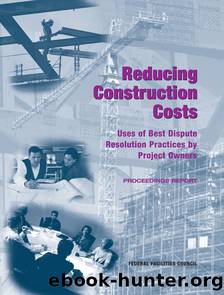REDUCING CONSTRUCTION COSTS: USES OF BEST DISPUTE RESOLUTION PRACTICES BY PROJECT OWNERS: PROCEEDINGS REPORT by Federal Facilities Council

Author:Federal Facilities Council
Language: eng
Format: epub
Tags: Engineering and Technology : Construction : Design, Research, Planning. Industry and Labor : Human Factors
Publisher: NATIONAL ACADEMY PRESS
Published: 2007-10-15T00:00:00+00:00
FIGURE 6.3 Bridging method.
CASE STUDIES EMPLOYING BRIDGING AND A STANDING DISPUTE RESOLUTION PANEL
Three bridging projects recently completed by Brookwood Program Management illustrate how bridging and use of a standing dispute resolution panel can help owners to save time and money and avoid disputes and change orders (see Table 6.1).
According to the statistics collected for the Georgia Institute of Technology project, only the pre-design schedule changed during the process. Actual completion and beneficial occupancy was one month ahead of schedule. The total time for final design and construction was 19 months. The actual cost was lower than anticipated, and the resulting $100,000 surplus enabled Georgia Tech to get the extras it wanted and contribute to a bond retirement reserve. There were no contractor-initiated change orders and no claims against the owner.
The Morehouse College Student Housing project finished 1 month ahead of schedule and the actual costs came in under budget. Morehouse used the $915,000 surplus to buy additional items for the activity rooms, the study carrels, and other spaces. There was only one contractor-initiated change order due to unusual weather conditions. However, there were no claims against the owner and no additional costs to correct post-construction problems.
The Georgia State University project finished one month ahead of schedule after 23 months of design and construction time. There were no contract-initiated change orders or claims against the owner.
All three of these projects show how bridging can benefit owners by significantly reducing risk and post-construction problems and enabling greater savings and scheduling efficiency. In all cases, bridging was combined with a standing dispute resolution panel requirement. However, the dispute resolution panel can be used effectively regardless of the chosen delivery method.
Download
This site does not store any files on its server. We only index and link to content provided by other sites. Please contact the content providers to delete copyright contents if any and email us, we'll remove relevant links or contents immediately.
Whiskies Galore by Ian Buxton(41717)
Introduction to Aircraft Design (Cambridge Aerospace Series) by John P. Fielding(33016)
Small Unmanned Fixed-wing Aircraft Design by Andrew J. Keane Andras Sobester James P. Scanlan & András Sóbester & James P. Scanlan(32683)
Aircraft Design of WWII: A Sketchbook by Lockheed Aircraft Corporation(32161)
Craft Beer for the Homebrewer by Michael Agnew(18080)
Turbulence by E. J. Noyes(7893)
The Complete Stick Figure Physics Tutorials by Allen Sarah(7264)
The Institute by Stephen King(6854)
Kaplan MCAT General Chemistry Review by Kaplan(6822)
The Thirst by Nesbo Jo(6755)
Bad Blood by John Carreyrou(6476)
Modelling of Convective Heat and Mass Transfer in Rotating Flows by Igor V. Shevchuk(6353)
Learning SQL by Alan Beaulieu(6158)
Weapons of Math Destruction by Cathy O'Neil(6084)
Man-made Catastrophes and Risk Information Concealment by Dmitry Chernov & Didier Sornette(5875)
Permanent Record by Edward Snowden(5680)
Digital Minimalism by Cal Newport;(5584)
Life 3.0: Being Human in the Age of Artificial Intelligence by Tegmark Max(5402)
iGen by Jean M. Twenge(5320)
